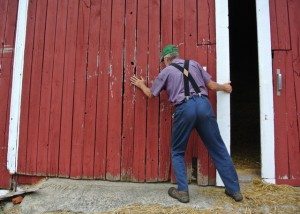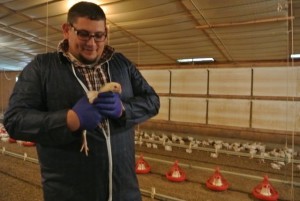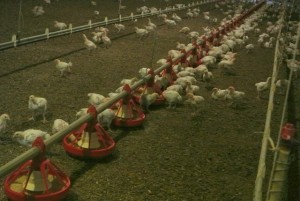Humanely Raised Chickens Hop Into (Johns) Hopkins

Neil Wertz, one of the farmers for Murray’s Chicken, opens the barn he raised chickens in as a child.
Cage free, humane, organic, local, fair, sustainable, healthy. We look for many attributes in the food we eat. According to Ecolabelindex, there are more than 400 different eco-labels vying to verify those attributes. As a company, Bon Appétit Management Company relies on independent, third-party certifications to assure ourselves and our guests that the commitments we make are meaningful and are being met.
As part of a sweeping series of animal welfare commitments in 2012, which included banning foie gras and crate-raised veal immediately, Bon Appétit also committed that by 2015, we’d be sourcing at least 25% of our meat, poultry and egg purchases from farms meeting one of four strict, independently verified animal welfare standards: Certified Humane, Food Alliance, Global Animal Partnership and Animal Welfare Approved. Those are the four labels that meet or surpass our bar for how we’d like to see food animals raised for their own well-being and the well-being of our guests and environment.
Sounds easy, right? Not so fast. Our biggest challenge is that the supply isn’t easy to find, and in many cases, doesn’t yet exist. That makes the commitment all the more impressive to me, and all the more complicated to implement. So in my role as Senior Fellow, I’ve made it a personal mission to develop an understanding of what’s behind each of those names.
When I heard that Bon Appétit chefs at Johns Hopkins University had started sourcing Certified Humane chicken from Murray’s Chicken, I jumped at the chance to see humanely raised poultry firsthand. Ty Paup, general manager for Johns Hopkins, and I drove out to visit two of the farms in Pennsylvania that supply Murray’s Chicken.
As I learned in a report from the Humane Society of the United States, the situation in America is pretty grim for “broiler” chickens, the industry term for chickens raised for meat, as opposed to the layers that supply eggs. I’ll spare you the horrific details, but the industry norm includes techniques that cause chickens to grow faster and fatter than is healthy, unsanitary conditions in the barns, no opportunity to indulge their natural behaviors in their short lives, and frequently abusive treatment.

Ty Paup, general manager for Bon Appétit at Johns Hopkins University, gets up close to a Murray’s “broiler”
Fortunately, Certified Humane farms differ in key ways. Like all the chicken (and turkey!) we serve in Bon Appétit cafes, these chickens were raised without the routine use of antibiotics as an additive to their feed or water. The farms must have what Murray’s Chicken Vice President Steve Gold refers to as “toys”: items that enrich the environment and allow the chickens to act out natural behaviors such as perching, dust bathing, and nesting.
The vast majority of chickens sold today have been bred for their large breast size — and not much else. Their breasts grow disproportionately and quickly. Too quickly, in fact, for the rest of their body to keep up with that growth in a healthy way, and they often end up with broken legs and other bones as a result. I was pleasantly surprised to learn that while Murray’s chickens are big breasted, this breed has legs proportionate to its breast size, making injuries less likely as they grow.
Some of the animal welfare standards are for extreme situations: the Certified Humane standard requires backup generators on site, so that the chickens don’t suffocate in the case of a power outing. Some, meanwhile, affect almost every moment of the chickens’ lives: each farm follows lighting protocols according to the standard, demonstrating that they are not manipulating light levels to make chickens grow faster at the expense of their health.

Water systems (to the left) have requirements for the nipple to chicken ratio, and the pipes are moved higher as the chickens grow for accessibility.
I didn’t have time to visit the slaughterhouse (I was invited, so stay tuned), but I heard some reassuring information about it. The Certified Humane standard dictates how chickens must be caught, transported and handled as well as some basics for more humane slaughter. Dr. Temple Grandin, the recognized expert on the design of slaughter facilities for the humane treatment of animals, uses a video of Murray’s plant as a positive example for the poultry industry. Upon applying for the Certified Humane certification about 10 years ago, the company only had to make a couple of changes. One example: making a bend in the line as the chickens move towards the point of slaughter, so that they can’t see the chickens ahead of them being killed.
I feel fortunate that we buy from vendors who are willing to open their doors to visitors to explain what they do, just as we at Bon Appétit open our kitchen doors and share the story of where our food comes from. It was a great learning experience and a unique opportunity to see a more humane and all-around healthier system of raising chickens. And now, when I see the Certified Humane label at the supermarket or on our chefs’ invoices, I will know what it means.